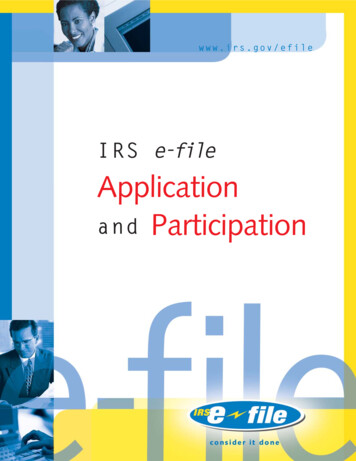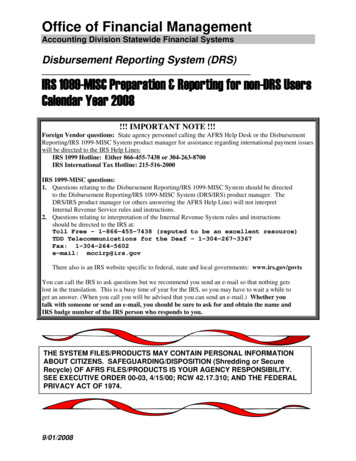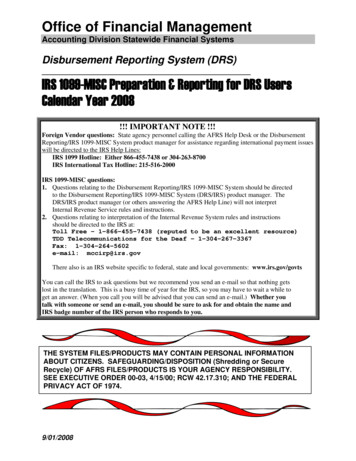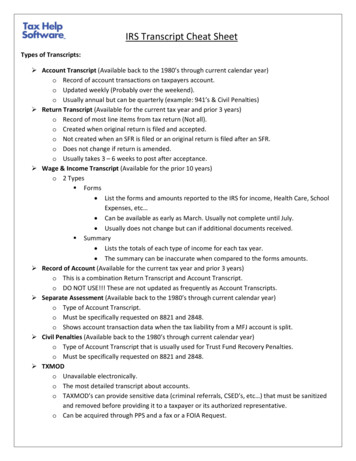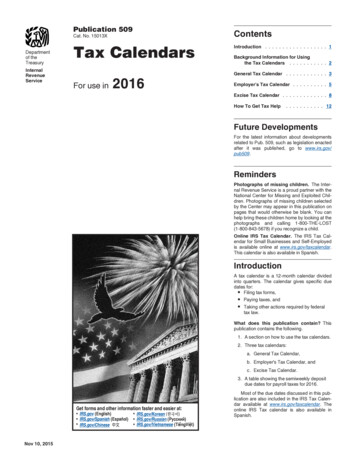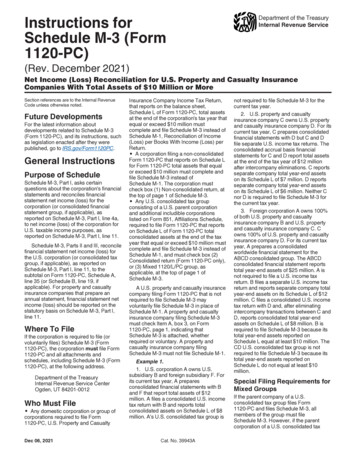
Transcription
Instructions forSchedule M-3 (Form1120-PC)Department of the TreasuryInternal Revenue Service(Rev. December 2021)Net Income (Loss) Reconciliation for U.S. Property and Casualty InsuranceCompanies With Total Assets of 10 Million or MoreSection references are to the Internal RevenueCode unless otherwise noted.Future DevelopmentsFor the latest information aboutdevelopments related to Schedule M-3(Form 1120-PC), and its instructions, suchas legislation enacted after they werepublished, go to IRS.gov/Form1120PC.General InstructionsPurpose of ScheduleSchedule M-3, Part I, asks certainquestions about the corporation's financialstatements and reconciles financialstatement net income (loss) for thecorporation (or consolidated financialstatement group, if applicable), asreported on Schedule M-3, Part I, line 4a,to net income (loss) of the corporation forU.S. taxable income purposes, asreported on Schedule M-3, Part I, line 11.Schedule M-3, Parts II and III, reconcilefinancial statement net income (loss) forthe U.S. corporation (or consolidated taxgroup, if applicable), as reported onSchedule M-3, Part I, line 11, to thesubtotal on Form 1120-PC, Schedule A,line 35 (or Schedule B, line 19, ifapplicable). For property and casualtyinsurance companies that prepare anannual statement, financial statement netincome (loss) should be reported on thestatutory basis on Schedule M-3, Part I,line 11.Where To FileIf the corporation is required to file (orvoluntarily files) Schedule M-3 (Form1120-PC), the corporation must file Form1120-PC and all attachments andschedules, including Schedule M-3 (Form1120-PC), at the following address.Department of the TreasuryInternal Revenue Service CenterOgden, UT 84201-0012Who Must File Any domestic corporation or group ofcorporations required to file Form1120-PC, U.S. Property and CasualtyDec 06, 2021Insurance Company Income Tax Return,that reports on the balance sheet,Schedule L of Form 1120-PC, total assetsat the end of the corporation's tax year thatequal or exceed 10 million mustcomplete and file Schedule M-3 instead ofSchedule M-1, Reconciliation of Income(Loss) per Books With Income (Loss) perReturn. A corporation filing a non-consolidatedForm 1120-PC that reports on Schedule Lfor Form 1120-PC total assets that equalor exceed 10 million must complete andfile Schedule M-3 instead ofSchedule M-1. The corporation mustcheck box (1) Non-consolidated return, atthe top of page 1 of Schedule M-3. Any U.S. consolidated tax groupconsisting of a U.S. parent corporationand additional includible corporationslisted on Form 851, Affiliations Schedule,required to file Form 1120-PC that reportson Schedule L of Form 1120-PC totalconsolidated assets at the end of the taxyear that equal or exceed 10 million mustcomplete and file Schedule M-3 instead ofSchedule M-1, and must check box (2)Consolidated return (Form 1120-PC only),or (3) Mixed 1120/L/PC group, asapplicable, at the top of page 1 ofSchedule M-3.A U.S. property and casualty insurancecompany filing Form 1120-PC that is notrequired to file Schedule M-3 mayvoluntarily file Schedule M-3 in place ofSchedule M-1. A property and casualtyinsurance company filing Schedule M-3must check Item A, box 3, on Form1120-PC, page 1, indicating thatSchedule M-3 is attached, whetherrequired or voluntary. A property andcasualty insurance company filingSchedule M-3 must not file Schedule M-1.Example 1.1. U.S. corporation A owns U.S.subsidiary B and foreign subsidiary F. Forits current tax year, A preparesconsolidated financial statements with Band F that report total assets of 12million. A files a consolidated U.S. incometax return with B and reports totalconsolidated assets on Schedule L of 8million. A's U.S. consolidated tax group isCat. No. 39943Anot required to file Schedule M-3 for thecurrent tax year.2. U.S. property and casualtyinsurance company C owns U.S. propertyand casualty insurance company D. For itscurrent tax year, C prepares consolidatedfinancial statements with D but C and Dfile separate U.S. income tax returns. Theconsolidated accrual basis financialstatements for C and D report total assetsat the end of the tax year of 12 millionafter intercompany eliminations. C reportsseparate company total year-end assetson its Schedule L of 7 million. D reportsseparate company total year-end assetson its Schedule L of 6 million. Neither Cnor D is required to file Schedule M-3 forthe current tax year.3. Foreign corporation A owns 100%of both U.S. property and casualtyinsurance company B and U.S. propertyand casualty insurance company C. Cowns 100% of U.S. property and casualtyinsurance company D. For its current taxyear, A prepares a consolidatedworldwide financial statement for theABCD consolidated group. The ABCDconsolidated financial statement reportstotal year-end assets of 25 million. A isnot required to file a U.S. income taxreturn. B files a separate U.S. income taxreturn and reports separate company totalyear-end assets on its Schedule L of 12million. C files a consolidated U.S. incometax return with D and, after eliminatingintercompany transactions between C andD, reports consolidated total year-endassets on Schedule L of 8 million. B isrequired to file Schedule M-3 because itstotal year-end assets reported onSchedule L equal at least 10 million. TheCD U.S. consolidated tax group is notrequired to file Schedule M-3 because itstotal year-end assets reported onSchedule L do not equal at least 10million.Special Filing Requirements forMixed GroupsIf the parent company of a U.S.consolidated tax group files Form1120-PC and files Schedule M-3, allmembers of the group must fileSchedule M-3. However, if the parentcorporation of a U.S. consolidated tax
group files Form 1120-PC and anymember of the group files a Form 1120 orForm 1120-L, U.S. Life InsuranceCompany Income Tax Return, thatmember must file a Form 1120Schedule M-3 or a Form 1120-LSchedule M-3, respectively, and the groupmust comply with the mixed groupconsolidated Schedule M-3 reportingdescribed under Schedule M-3Consolidation for Mixed Groups (1120/L/PC), later. A mixed group must also fileForm 8916, Reconciliation ofSchedule M-3 Taxable Income with TaxReturn Taxable Income for Mixed Groups,and, if applicable, Form 8916-A,Supplemental Attachment toSchedule M-3.If the parent company of a U.S.consolidated tax group files Form1120-PC, and any member of the groupfiles Form 1120 or Form 1120-L, and theconsolidated Schedule L reported in thereturn includes the assets of all of thecompanies (insurance companies as wellas the non-insurance companies), in orderto determine if the group meets the 10million threshold test for the requirementto file Schedule M-3, use the amount oftotal assets reported on Schedule L of theconsolidated return. If the parent companyof a U.S. consolidated tax group files Form1120-PC and any member of the groupfiles Form 1120 or Form 1120-L and theconsolidated Schedule L reported in thereturn does not include the assets of oneor more of the insurance companies in theU.S. consolidated tax group, in order todetermine if the group meets the 10million threshold test for the requirementto file Schedule M-3, use the sum of theamount of total assets reported on theconsolidated Schedule L plus the amountsof all assets reported on Forms 1120 and1120-L that are included in theconsolidated return but not included onthe consolidated Schedule L.For insurance companies included inthe consolidated U.S. income tax return,see instructions for Part I, lines 10a, 10b,10c, and 11, and Part II, line 7, forguidance on Schedule M-3 reporting ofintercompany dividends and statutoryaccounting adjustments.Other Issues AffectingSchedule M-3 FilingRequirementsIf a property and casualty insurancecompany was required to fileSchedule M-3 for the preceding tax yearbut reports on Schedule L of Form1120-PC total consolidated assets at theend of the current tax year of less than 10million, the property and casualtyinsurance company is not required to fileSchedule M-3 for the current tax year. Theproperty and casualty insurance companymay voluntarily file Schedule M-3 for thecurrent tax year. If for a subsequent taxyear the property and casualty insurancecompany is required to file Schedule M-3,the property and casualty insurancecompany must complete Schedule M-3 inits entirety for that subsequent tax year.In the case of a U.S. consolidated taxgroup, total assets at the end of the taxyear must be determined based on thetotal year-end assets of all includiblecorporations listed on Form 851, net ofeliminations for intercompany transactionsand balances between the includiblecorporations. In addition, for purposes ofdetermining for Schedule M-3 whether thecorporation (or U.S. consolidated taxgroup) has total assets at the end of thecurrent tax year of 10 million or more, thecorporation's total consolidated assetsmust be determined on an overall accrualmethod of accounting unless both of thefollowing apply: (a) the tax returns of allincludible corporations in the U.S.consolidated tax group are prepared usingan overall cash method of accounting, and(b) no includible corporation in the U.S.consolidated tax group prepares or isincluded in financial statements preparedon an accrual basis.Note. See the instructions for Part I,line 1, for a discussion of non-tax-basisincome statements and relatednon-tax-basis balance sheets to be usedin the preparation of Schedule M-3 andForm 1120-PC, Schedule L.Other Form 1120-PCSchedules Affected bySchedule M-3RequirementsReport on Schedules L and Form1120-PC, Schedule A (or Schedule B, ifapplicable), amounts for the U.S.corporation or, if applicable, the U.S.consolidated tax group.Schedule L, Balance SheetIf a non-tax-basis income statement andrelated non-tax-basis balance sheet areprepared for any purpose for a periodending with or within the tax year,Schedule L must be prepared showingnon-tax-basis amounts. See theinstructions for Schedule M-3, Part I,line 1, for the discussion of non-tax-basisincome statements and relatednon-tax-basis balance sheets prepared forany purpose and the impact on theselection of the income statement used forSchedule M-3 and the relatednon-tax-basis balance sheet amounts thatmust be used for Schedule L.Total assets shown on Schedule L,line 15, column (d), must equal the totalassets of the property and casualtyinsurance company (or, in the case of a-2-U.S. consolidated tax group, the totalassets of all members of the group listedon Form 851) as of the last day of the taxyear. The same amount of total assetsmust be reported by the property andcasualty insurance company (or by eachmember of the U.S. consolidated taxgroup) in the non-tax-basis financialstatements, if any, used for Schedule M-3.If the property and casualty insurancecompany prepares non-tax-basis financialstatements, Schedule L must equal thesum of the non-tax-basis financialstatement total assets for eachcorporation listed on Form 851 andincluded in the consolidated U.S. incometax return (includible corporation) net ofeliminations for intercompany transactionsbetween includible corporations. If theproperty and casualty insurance companydoes not prepare non-tax-basis financialstatements, Schedule L must be based onthe property and casualty company'sbooks and records. The Schedule Lbalance sheet may show tax-basisbalance sheet amounts if the property andcasualty insurance company is allowed touse books and records for Schedule M-3and the property and casualty insurancecompany's books and records reflect onlytax-basis amounts.Generally, total assets at the beginningof the year (Schedule L, line 15, column(b)) must equal total assets at the close ofthe prior year (Schedule L, line 15, column(d)). For each Schedule L balance sheetitem reported for which there is adifference between the current yearopening balance sheet amount and theprior year closing balance sheet amount,attach a statement that reports thebalance sheet item, the prior closingamount, the current opening amount, anda short explanation of the change.Reasons for these differences includemergers and acquisitions.For purposes of measuring total assetsat the end of the year, the corporation'sassets may not be netted or reduced bythe corporation's liabilities. In addition,total assets may not be reported as anegative amount. If Schedule L isprepared on a non-tax-basis method, aninvestment in a partnership may be shownas appropriate under the corporation'snon-tax-basis method of accounting,including, if required by the corporation'sreporting methodology, the equity methodof accounting for investments. IfSchedule L is prepared on a tax basis, aninvestment by the corporation in apartnership must be shown as an assetand measured by the corporation'sadjusted basis in its partnership interest.Any liabilities contributing to such adjustedbasis must be shown on Schedule L ascorporate liabilities.Instructions for Schedule M-3 (Form 1120-PC)
Schedule M-2The amount shown on Schedule M-2,line 2, Net income (loss) per books, mustequal the amount shown onSchedule M-3, Part I, line 11.Schedule M-2 must reflect activity only ofcorporations included in the consolidatedU.S. income tax return.Consolidated Return (Form1120-PC)Report on Form 1120-PC each item ofincome, gain, loss, expense, or deductionnet of elimination entries for intercompanytransactions between includiblecorporations. The corporation must notreport as dividends on Form 1120-PC,Schedule A, any amounts received froman includible corporation unless thecorporation receiving the intercompanydividends is an insurance company andonly to the extent that the insurancecompany is required to includeintercompany dividends in taxableincome. (See the instructions for Part I,lines 10a, 10b, 10c, and 11, for adiscussion of intercompany dividends andinsurance company statutory accounting.)In general, dividends received from anincludible corporation must be eliminatedin consolidation rather than offset by thedividends-received deduction.Entity Considerations forSchedule M-3For purposes of Schedule M-3, referencesto the classification of an entity (forexample, as a corporation, a partnership,or a trust) are references to the treatmentof the entity for U.S. income tax purposes.An entity that is generally disregarded asseparate from its owner for U.S. incometax purposes (disregarded entity) must notbe separately reported on Schedule M-3except, if required, on Part I, line 7a or 7b.On Schedule M-3, Parts II and III, any itemof income, gain, loss, deduction, or creditof a disregarded entity must be reportedas an item of its owner. In particular, theincome or loss of a disregarded entitymust not be reported on Part II, line 9, 10,or 11 as a separate partnership or otherpass-through entity. The financialstatement income or loss of a disregardedentity is included on Part I, line 7a or 7b,only if its financial statement income orloss is included on Part I, line 11, but noton Part I, line 4a.Reportable Entity PartnerReporting ResponsibilitiesA reportable entity partner with respect toa partnership filing Form 1065, U.S.Return of Partnership Income, is an entitythat: Owns or is deemed to own, directly orindirectly, under these instructions a 50%or greater interest in the income, loss, orcapital of the partnership on any day of thetax year; and Was required to file Schedule M-3 on itsmost recently filed U.S. income tax returnor return of income filed prior to that day.For the purposes of these instructions,the following rules apply.1. The parent corporation of aconsolidated tax group is deemed to ownall corporate and partnership interestsowned or deemed to be owned underthese instructions by any member of thetax consolidated group.2. The owner of a disregarded entityis deemed to own all corporate andpartnership interests owned or deemed tobe owned under these instructions by thedisregarded entity.3. The owner of 50% or more of acorporation by vote on any day of thecorporation’s tax year is deemed to ownall corporate and partnership interestsowned or deemed to be owned underthese instructions by the corporationduring its tax year.4. The owner of 50% or more ofpartnership income, loss, or capital on anyday of the partnership tax year is deemedto own all corporate and partnershipinterests owned or deemed to be ownedunder these instructions by thepartnership during the partnership taxyear.5. The beneficial owner of 50% ormore of the beneficial interest of a trust ornominee arrangement on any day of thetrust or nominee arrangement tax year isdeemed to own all corporate andpartnership interests owned or deemed tobe owned under these instructions by thetrust or nominee arrangement.A reportable entity partner with respectto a partnership (as defined above) mustreport the following to the partnershipwithin 30 days of first becoming areportable entity partner and, after firstreporting to the partnership under theseinstructions, thereafter within 30 days ofthe date of any change in the interest itowns or is deemed to own, directly orindirectly, under these instructions, in thepartnership.1. Name.2. Mailing address.3. Taxpayer identification number(TIN or EIN), if applicable.4. Entity or organization type.5. State or country in which it isorganized.6. Date on which it first became areportable entity partner.7. Date with respect to which it isreporting a change in its ownershipinterest in the partnership, if applicable.Instructions for Schedule M-3 (Form 1120-PC)-3-8. The interest in the partnership itowns or is deemed to own in thepartnership, directly or indirectly (asdefined under these instructions) as of thedate with respect to which it is reporting.9. Any change in that interest as of thedate with respect to which it is reporting.The reportable entity partner mustretain copies of required reports it makesto partnerships under these instructions.Each partnership must retain copies of therequired reports it receives under theseinstructions from reportable entitypartners.Example 2.1. Z, a U.S. property and casualtyinsurance company, owns 50% of A, anLLC filing Form 1065 for 2021. A owns50% of B, C, D, and E, which are alsoLLCs filing a Form 1065 for calendar year2021. Z was first required to fileSchedule M-3 (Form 1120-PC) for itscorporate tax year ended December 31,2020, and filed its Schedule M-3 withForm 1120-PC for 2020 on October 15,2021. As of October 16, 2021, Z was areportable entity partner with respect to Aand, through A, with respect to B, C, D,and E. On November 5, 2021, Z reports toA, B, C, D, and E, as it is required to dowithin 30 days of October 16, that Z is areportable entity partner directly owning(with respect to A) or deemed to ownindirectly (with respect to B, C, D, and E) a50% interest. Therefore, because Z was areportable entity partner for 2021, each ofA, B, C, D, and E is required to fileSchedule M-3 (Form 1065), for 2021,regardless of whether they wouldotherwise be required to file Schedule M-3for that year.2. P, a U.S. property and casualtyinsurance company, is the parent of afinancial consolidation group with 50domestic subsidiaries, DS1 through DS50,and 50 foreign subsidiaries, FS1 throughFS50, all 100% owned on October 16,2021. On October 15, 2021, P filed aconsolidated tax return on Form 1120-PCand was required to file Schedule M-3 forthe tax year ending December 31, 2020.On October 16, 2021, DS1, DS2, DS3,FS1, and FS2 each acquire a 10%partnership interest in partnership K whichfiles Form 1065 for the tax year endingDecember 31, 2021. P is deemed to own,directly or indirectly (under theseinstructions), all corporate and partnershipinterests of DS1, DS2, and DS3, as theparent of the tax consolidation group andtherefore is deemed to own 30% of K onOctober 16, 2021. P is deemed to own,directly or indirectly (under theseinstructions), all corporate and partnershipinterests of FS1 and FS2 as the owner of50% or more of each corporation by voteand therefore is deemed to own 20% of Kon October 16, 2021. P is therefore
deemed to own 50% of K on October 16,2021. Since P owns or is deemed to own,directly or indirectly (under theseinstructions), 50% or more of K onOctober 16, 2021, and was required to fileSchedule M-3 with its most recently filedU.S. income tax return filed prior to thatdate, P is a reportable entity partner of Kas of October 16, 2021. On November 5,2021, P reports to K that P is a reportableentity partner as of October 16, 2021,deemed to own (under these instructions)a 50% interest in K. K is, therefore,required to file Schedule M-3 when it filesits Form 1065 for its tax year endingDecember 31, 2021.ConsolidatedSchedule M-3 VersusConsolidating SchedulesM-3 for Form 1120-PCGroupsA consolidated tax return group with aparent corporation that files a Form1120-PC is a mixed group if any memberis a life insurance company (files Form1120-L, U.S. Life Insurance CompanyIncome Tax Return) or is not an insurancecompany. See Schedule M-3Consolidation for Mixed Groups (1120/L/PC), later.A U.S. consolidated tax group must filea consolidated Schedule M-3. Parts I, II,and III of the consolidated Schedule M-3must reflect the activity of the entire U.S.consolidated tax group. The parentcorporation must also complete Parts IIand III of a separate Schedule M-3 toreflect the parent's own activity. Inaddition, Parts II and III of a separateSchedule M-3 must be completed by eachincludible corporation to reflect the activityof that includible corporation. Lastly, itgenerally will be necessary to completeParts II and III of a separate Schedule M-3for consolidation eliminations.If a U.S. consolidated tax group that isnot a mixed group consists of fourincludible corporations (the parent andthree subsidiaries) all filing Form 1120-PC,the U.S. consolidated tax group mustcomplete six Schedules M-3 as follows. One consolidated Schedule M-3 withParts I, II, and III completed to reflect theactivity of the entire U.S. consolidated taxgroup. Parts II and III of a separateSchedule M-3 for each of the fourincludible corporations to reflect theactivity of each includible corporation. Parts II and III of a separateSchedule M-3 to eliminate intercompanytransactions between includiblecorporations and to include limitations ondeductions (for example, charitablecontribution limitations and capital losslimitations) and carryover amounts (forexample, charitable contributioncarryovers and capital loss carryovers).See Completion of Schedule M-3 andCertain Allocations, Limitations, andCarryovers, later.Note. Complete only one Schedule M-3,Part I, for each consolidated group. Asubsidiary of a consolidated group doesnot complete Schedule M-3, Part I. Enteron Part I the name and EIN of the commonparent of the consolidated group.Indicate on each Schedule M-3, Parts IIand III, on the line after the commonparent's name and EIN, whether theSchedule M-3, Parts II and III, is for the:1. Consolidated group,2. Parent corporation,3. Consolidation eliminations, or4. Subsidiary corporation,by checking the appropriate box. If Parts IIand III are for a subsidiary in aconsolidated return, also enter the nameand EIN of the subsidiary.Schedule M-3 Consolidation forMixed Groups (1120/L/PC)Special Schedule M-3 consolidation rulesapply to a mixed group, that is, aconsolidated tax group that:1. Includes both a corporation that isan insurance company and a corporationthat is not an insurance company, or2. Includes both a life insurancecompany and a property and casualtyinsurance company, or3. Includes a life insurance company,a property and casualty insurancecompany, and a corporation that is not aninsurance company.Mixed group consolidation forSchedule M-3, Parts II and III, requires:1. Subgroup sub-consolidation of the1120 subgroup, the 1120-PC subgroup,and the 1120-L subgroup, each with itsown sub-consolidated Schedule M-3,Parts II and III, and2. Consolidation of the subgroupsub-consolidation totals on a consolidatedSchedule M-3, Part II, that ties to aconsolidated Schedule M-3, Part I, and aconsolidated Form 8916, Reconciliation ofSchedule M-3 Taxable Income with TaxReturn Taxable Income for Mixed Groups.In addition to one Schedule M-3, Part II,and one Schedule M-3, Part III, for eachcorporation in the three subgroupsub-consolidations, there will generally bea total of six additional Schedule M-3,Parts II, and six additional Schedule M-3,Parts III, for the subgroupsub-consolidations. Specifically, theremust be one Part II, and one Part III, foreach subgroup's sub-consolidatedamounts and one Part II, and one Part III,-4-for each subgroup's sub-consolidationeliminations amounts.At the mixed group consolidated level,there must be a consolidatedSchedule M-3, Part II, and, if applicable, aPart II, for consolidation eliminations notincludible in the subgroup eliminations. Atthe consolidated level there must also bea consolidated Schedule M-3, Part I, and aconsolidated Form 8916. For a mixedgroup, there is no Schedule M-3, Part III,at the consolidated level. At theconsolidated level, use the Schedule M-3(Form 1120, 1120-PC, or 1120-L), Parts Iand II, that match the form on which theparent corporation reports and the entireconsolidated group files.The corporation must check theapplicable mixed group checkboxes on allSchedules M-3, Parts I, II, and III, asdiscussed below.Subgroup Sub-Consolidation:1120 Subgroup, 1120-PCSubgroup, and 1120-L SubgroupA subgroup Schedule M-3, Parts II and III,sub-consolidation must be prepared withall necessary eliminations within thesubgroup for each of the three possiblesubgroups that are in fact present. One subgroup for those corporationsreporting on Form 1120, One subgroup for those corporationsreporting on Form 1120-PC, and One subgroup for those reporting onForm 1120-L.The parent corporation is included in thesubgroup that corresponds to the form onwhich it reports and the entireconsolidated group files. For example, inthe case of a Form 1120-PC parent andForm 1120-PC consolidated group, theparent is included in the Form 1120-PCsubgroup sub-consolidation. Eachsubgroup uses its own Schedule M-3(Form 1120, 1120-PC, or 1120-L), Parts IIand III, for each corporation within thesubgroup and for the subgroupsub-consolidation and the subgroupeliminations.The three subgroup sub-consolidationtaxable income calculations onSchedule M-3 must follow the separatereturn requirements of the regulationsunder section 1502 and all otherapplicable regulations taking into accountthe amounts separately reported on Form8916. Capital loss limitation andcarryforward used and charitablededuction limitation and carryforward usedare not taken into account in thedetermination of the three subgroupsub-consolidated taxable incomes onSchedule M-3, but are reflected on Form8916 and in the calculation of the life/non-life loss limitation and carryforwardInstructions for Schedule M-3 (Form 1120-PC)
used. See Life/Non-Life Loss Limitationand Carryforward Used Calculations, later.The reconciliation totals for book,temporary difference, permanentdifference, and taxable income for eachsubgroup are reported on Form 1120,1120-PC, or 1120-L, as applicable,Schedule M-3, Part II, line 29a, columns(a), (b), (c), and (d), and equal the sum ofthe line amounts on Part II, lines 26through 28. For a mixed group,Schedule M-3, Part II, lines 29b, 29c, and30 are blank on the Form 1120, 1120-PC,or 1120-L, as applicable, for the separatecorporations (parent and subsidiary) andfor the three subgroup sub-consolidations.Note. A sub-consolidation is required forevery subgroup, even if the subgroupconsists of only one corporation. Inaddition, Form 8916-A, if applicable, isrequired at the sub-consolidated level andthe sub-consolidated elimination level.Reconciliation of Mixed GroupSubgroup Sub-ConsolidationAmounts to Schedule M-3, Part I,Line 11, and to Tax Return TaxableIncomeAt the consolidated level, use theSchedule M-3 (Form 1120, 1120-PC, or1120-L), Parts I and II, that matches theform on which the parent corporationreports and the entire consolidated groupfiles. For a mixed group, the consolidatedSchedule M-3, Part II, lines 29a, 29b, and29c amounts report the applicableamounts from the three subgroupsub-consolidation Part II, line 29a,amounts. (If a consolidated level Part II forconsolidation eliminations not includible inthe subgroup eliminations is applicable,the applicable amounts must be adjustedby the applicable elimination amounts.)The consolidated Schedule M-3, Part II,line 30, amounts are the sums of theapplicable amounts on the consolidatedPart II, lines 29a, 29b, and 29c. For amixed group, the consolidated Part II, lines1 through 28, are blank and noconsolidated Part III is required to becompleted.For mixed groups, the consolidatedPart II, line 30, column (a), must equal PartI, line 11, with appropriate adjustments forstatutory accounting requirementsreflected on Part I, lines 10a and 10b. Theconsolidated taxable income indicated onPart II, line 30, column (d), must equal theamount shown on Form 8916, line 1. Form8916, line 8, must equal taxable incomereported on the tax return.Completion of Mixed GroupCheckboxes for Schedule M-3,Part II and Part IIINote. The following discussion ofcheckboxes will assume that the 1120-PCsubgroup includes the corporate parent ofthe mixed group.Forms 1120, 1120-PC, and 1120-L,Schedule M-3, Parts II and III, each have acheckbox (5) at the top indicating a mixedgroup. Checkbox (5) and one or moreother applicable checkboxes must bechecked for a mixed group.For example, an 1120-PC parentcorporation included in the 1120-PCsubgroup must check Form 1120-PC,Schedule M-3, Parts II and III, box (2)Parent corporation, and box (5) Mixed1120/L/PC group. An 1120-PC subsidiarycorporation within the 1120-PC subgroupmust check Form 1120-PC,Schedule M-3, Parts II and III, box (4)Subsidiary corporation, and box (5) Mixed1120/L/PC group. An 1120 subsidiarycorporation within the 1120 subgroupmust check Form 1120, Schedule M-3,Parts II and I
Company Income Tax Return, that member must file a Form 1120 Schedule M-3 or a Form 1120-L Schedule M-3, respectively, and the group must comply with the mixed group consolidated Schedule M-3 reporting described under Schedule M-3 Consolidation for Mixed Groups (1120/L/ PC), later. A mixed group must also file Form 8916, Reconciliation of







